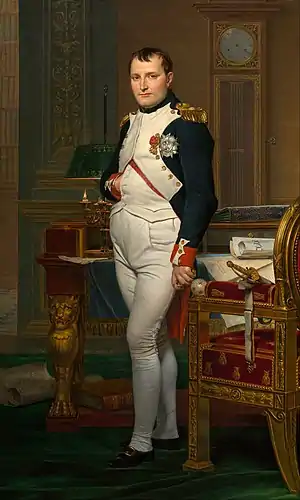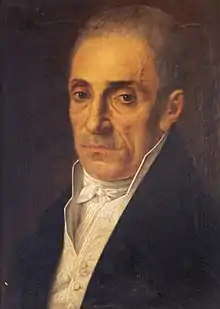Spanish reconquest of Santo Domingo
Spanish reconquest of Santo Domingo (Spanish: Reconquista Española de Santo Domingo) was the war for Spanish reestablishment in Santo Domingo, or better known as the Reconquista, and was fought between November 7, 1808, and July 9, 1809. In 1808, following Napoleon's invasion of Spain, the criollos of Santo Domingo revolted against French rule and their struggle culminated in 1809 with a return to the Spanish colonial rule for a period commonly termed España Boba.
| Reconquista | |||||||
|---|---|---|---|---|---|---|---|
| Part of the Napoleonic Wars | |||||||
 Map of Hispaniola and Puerto Rico | |||||||
| |||||||
| Belligerents | |||||||
|
|
| ||||||
| Commanders and leaders | |||||||
|
|
| ||||||
| Strength | |||||||
|
2,000 6 frigates | 2,600 | ||||||
Background
Treaty of Basel
.svg.png.webp)
The war between Spain and the Convention ended with the cession of the eastern part of the island of Santo Domingo to France, in exchange for the return of the peninsular territories occupied by the army French, as stipulated in the Treaty of Basel, signed on July 22, 1795 between both countries. The situation of general chaos in which the French part of the island was immersed, due to the uprising of the slaves and the struggles unleashed between the various ethnic and social groups, caused the sine day postponement of the definitive handover of the colony by the Spanish authorities to the French ones. However, the consequences of the news were not long in coming, and a large number of Dominican families left the island bound for Puerto Rico, Cuba and Venezuela in a migration process that increased when soldiers commanded by Toussaint Louverture, a former slave who had become general of the French Republic, entered Santo Domingo almost without resistance, in 1801, to take possession of the territory that Spain had ceded to France. The expedition sent by Napoleon Bonaparte to the island in 1802, headed by General Charles Leclerc, did not manage to restore order, but rather lost control over the western part of the island, in which French rule was already more virtual than real, unlike of what was happening in Santo Domingo, whose population supported the new authorities as a safeguard against their neighbors to the west. After the proclamation of Haitian independence in 1804, the eastern part remained under the power of France.
French occupation

During the French era in Santo Domingo, from 1802 and especially from 1804, there were undoubtedly convinced Francophiles among the Dominicans. The brilliance of Napoleonic France was perceived and had its effects in the country. After the failed invasion of Jean-Jacques Dessalines in 1805, it was realized that a competent and progressive administration was beginning; It was noted that the French governor, General Jean-Louis Ferrand, was a capable and well-intentioned man.[1]
During his government, the French took care of the reconstruction and consolidation of the Colony. Ferrand launched proclamations abroad calling on the French to live in Santo Domingo; Many responded to the call, as did some Spanish families, and thus things continued to improve incredibly after so many vicissitudes. In Samaná, for example, which until then had been a poor and forgotten village, the Government encouraged the planting of coffee plantations that already in 1808 promised to give new life to this region, whose French population grew so much that Ferrand even had the plans prepared. of a modern city that would be named Port Napoleon. The wood forests, which until then had been exploited very sporadically, were subject to regular exploitation, since the Island's mahogany, due to its beauty, was in great demand in the United States and Europe. Taxes were reduced to the minimum in order to help the inhabitants of the Colony recover their fortunes.[1]
Ferrand established a paternal government, supported by a decree from Napoleon in 1803, through which he ordered respect for Spanish uses and customs, especially as far as the legal organization was concerned. The truth was that there was collaboration between the population and the authorities, although Ferrand, convinced that Hispanic feelings were still alive among the vast majority of the population, avoided, as much as possible, the opportunities to make them feel his power.[1]
French invasion of Spain

That same year, Napoleon invaded Spain, leading to Tlthe abdication of King Charles IV as a consequence of the Aranjuez mutiny, and the proclamation of Ferdinand VII caused a dynastic and political crisis that was used by Napoleon, whose troops had entered Spain heading towards Portugal, to confine the entire royal family in Bayonne, and put his brother José on the Spanish throne. Following the outbreak of the popular uprising against the French invasion, in May 1808, there was a subsequent reaction in the Spanish territories of America, in favor of the cause of the deposed Ferdinand VII.
In Santo Domingo, particularly, where the French ruled over a population that still considered itself Spanish, Napoleon's betrayal against the monarchs of Spain provoked the indignation of the most important property owners who now considered themselves doubly humiliated by knowing that the "Motherland" had fallen under French rule and saw its businesses damaged by the prohibition on selling its livestock to Haitians.
Battle of Palo Hincado

The first battle took place in Palo Hincado on November 7, 1808, when Gen. Juan Sánchez Ramírez, leading an army of local and Puerto Rican soldiers, attacked by surprise a garrison of the French Army under the command of Governor Marie-Louis Ferrand, who committed suicide later after. Gen. Joseph-David de Barquier heard the news and garrisoned 2000 soldiers in Santo Domingo.
Battle for Santo Domingo
The Siege of Santo Domingo of 1808 was the second and final major battle and was fought between November 7, 1808, and July 11, 1809, at Santo Domingo, Colony of Santo Domingo. A force of Dominican and Puerto-Rican of 1850 troops led by Gen. Juan Sánchez Ramírez, with a naval blockade by British Commander Hugh Lyle Carmichael, besieged and captured the city of Santo Domingo after an 8 months siege of the 2000 troops of the French Army led by Gen. Barquier.
British involvement
British Major General Hugh Lyle Carmichael departed Jamaica with the 2nd West Indian, 54th, 55th, and Royal Irish regiments to aid Britain's new found Spanish allies in reducing the isolated French garrison besieged in south-eastern Hispaniola. His convoy was escorted by Capt. William Price Cumby's HMS Polyphemus, Aurora, Tweed, Sparrow, Thrush, Griffin, Lark, Moselle, Fleur de la Mer, and Pike. Carmichael disembarked at Palenque (50 km or 30 mi west of Santo Domingo) on 28 June, hastening ahead of his army to confer with his Spanish counterpart— General Juan Sánchez Ramírez, commander of a Puerto Rican regiment and numerous local guerrillas—who for the past eight months had been investing the 1,200-man French garrison commanded by Brig. Gen. Joseph-David de Barquier.
Despite 400 of the 600 Spanish regulars being sick, they advanced on 30 June at Carmichael's behest to seize San Carlos Church on the outskirts of the capital and cut off communication between Santo Domingo and Fort San Jerónimo 3 km (2 mi) west, while simultaneously securing a beach for Cumby's supporting squadron. The demoralized French defenders had already requested an armistice and been rebuffed, repeating the suggestion on 1 July as the first British troops arrived overland (hampered by torrential rains). As negotiations progressed Carmichael maintained pressure by installing heavy siege batteries around the city and massing his forces for an assault.
French surrender
On 6 July the capitulation was finalized, de Barquier pointedly surrendering to the British rather than to the Spaniards. The next day British troops occupied the city and Fort San Jerónimo, the French defenders being transported directly to Port Royal, Jamaica without loss of life on either side.
References
- "Battle of Palo Hincado, La Reconquista". Educando.edu. Retrieved October 18, 2023.
- Delafosse, Lemonier; "Second Campaign of Santo Domingo — Dominican-French War of 1808" (translation of C. Armando Rodriguez); Editorial El Diario, Santiago (DR); 1946.
- Guillermin, Gilbert; "Journal History of the Spanish revolution of Santo Domingo" (translation C. Armando Rodriguez); Dominican Academy of History; Imp editing PV Lafourcade, Philadelphia, U.S.; 1810.
- Sánchez Ramírez, Juan; " Journal of the Reconquista"; Editor Montalvo, Santo Domingo (R.D.); 1957.
Bibliography
- Marley, David. Wars of the Americas: A Chronology of Armed Conflict in the New World, 1492 to the PresentABC-CLIO (1998). ISBN 0874368375